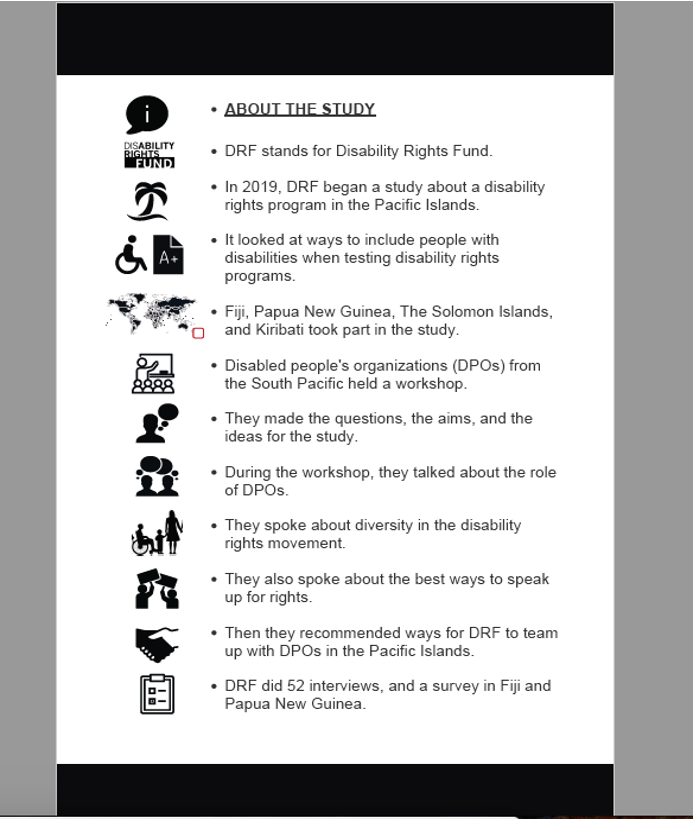
Hello! My name is Melanie Kawano-Chiu, and I lead evaluation and learning at the Disability Rights Fund/Disability Rights Advocacy Fund (DRF/DRAF), a participatory grantmaker that resources persons with disabilities. With more than a decade of experience in peacebuilding and advocacy evaluation, I’m here to share an approach that grounds monitoring, evaluation, and learning in human rights and principles of inclusion.
As a learning organization, DRF/DRAF asks two questions regarding evaluation. First, how should methods and frameworks change when our target community includes people who have been marginalized through their disability status and often further marginalized through their sexual orientation, gender expressions or characteristics, socio-economic status, or age?
Persons with disabilities are often excluded from evaluation processes. This lack of inclusion can lead to skewed conclusions, since reliable findings are based in large part on bias-free and comprehensive processes.
So, methods need to be selected based on their ability to include marginalized persons. A recent evaluation of DRF/DRAF, led by BLE Solutions, utilized contribution analysis and the equity-inclusive definition of value for money. This evaluation was also guided by an advisory board of persons with disabilities or family members of persons with disabilities.
This leads to our second question: how can authentic participation (meaning decision-making authority and not just consultation) contribute to furthering advocacy achievements by self-advocates? People from marginalized groups must be included in all aspects of programs that impact them – including evaluations. In a second recent DRF/DRAF evaluation, led by Strategic Leadership, the principles and evaluation questions were determined entirely by the target community. Some ownership in political processes like evaluations goes a long way toward countering everyday marginalization.
As a mother gifted with the opportunity to raise a child whose neurodiversity plays out daily through a range of sensory hypersensitivities, I am learning how to embrace and help validate a perspective wholly different from mine at work and at home. May you do the same in your evaluation practices!
Hot Tips:
- Prepare for the challenging conversation that reminds evaluation commissioners and funders that the main stakeholders of the evaluation are the target communities that will be evaluated and that affords them certain rights accordingly.
- Ensure members of marginalized groups are making evaluation design decisions.
- One in every six people has a disability. Budget for inclusive communications and more forms of evaluation findings dissemination, such as an Easy-to-Read version (pictured
right), or resources that reframe the findings of the evaluation for target communities. Language translations are only the start of fostering shared learning and ethical evaluation.

Rad Resources:
- The UN’s guidance note A Human Rights-Based Approach to Data is a great starting point for rights-based principles.
- To be inspired and equipped for discussions on how validity is called into question without inclusion, check out this seminal inclusive evaluation article and this discussion on the advantages and challenges of inclusive evaluation.
The American Evaluation Association is hosting APC TIG Week with our colleagues in the Advocacy and Policy ChangeTopical Interest Group. The contributions all this week to aea365 come from our AP TIG members. Do you have questions, concerns, kudos, or content to extend this aea365 contribution? Please add them in the comments section for this post on the aea365 webpage so that we may enrich our community of practice. Would you like to submit an aea365 Tip? Please send a note of interest to aea365@eval.org. aea365 is sponsored by the American Evaluation Association and provides a Tip-a-Day by and for evaluators. These views and opinions do not necessarily represent those of the American Evaluation Association, and/or any/all contributors to this site.

Thanks for a great post, Melanie! It looks like the file for the first link to the evaluation report is password protected. I would love to see this report if possible. Thank you!
Hi Melanie,
My name is Jacqueline O’Rourke and I am currently enrolled in my Professional Master of Education at Queen’s University. This semester my course is all about evaluation and I was so intrigued to read your article to learn more about how we can reframe the evaluation process to build equity and inclusion.
Thank you so much for sharing your insights on this topic. I agree that excluding people with disabilities from the evaluation does not allow for the full picture to be shown. I am a firm believer that representation matters always. As a classroom teacher, I try my best to ensure that neurodiversity is normalized and represented in our library and day-to-day activities. So, why shouldn’t evaluations do the same? Especially since the evaluations are taking place in order to better assist said target population.
It really resonated with me when you wrote that people with disabilities are often further marginalized from society due to their gender, sexual orientation, or socioeconomic status, and should not only be consulted in the evaluation but play a decision-making role. Is there a way that you believe evaluators or programs should best approach this?
I really enjoyed your Hot Tips section and how you included the example of an easy-to-read version of the results. It is so important for the results of an evaluation to be provided in a format that will enhance the use and recommendations of the evaluation.
In your rad resources section, you linked to an article that I was unfortunately unable to access. However, I would love to learn more about the discussions of validity when taking a participatory approach including populations with disabilities. Could you recommend where to start that search?
Thanks so much!
-Jacqueline